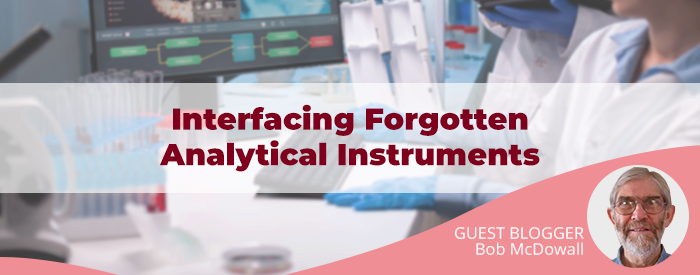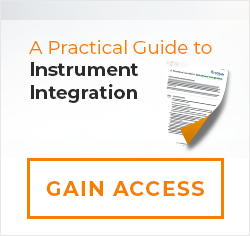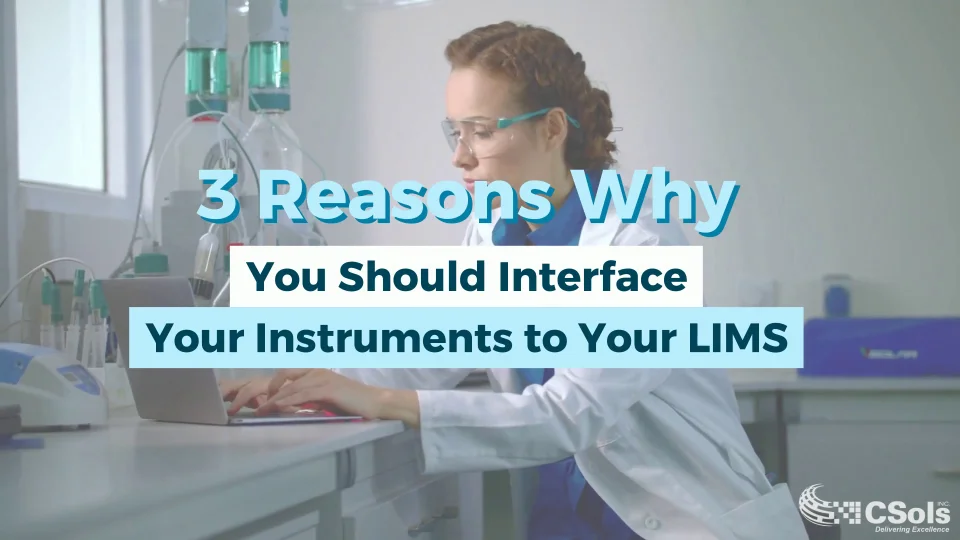Interfacing Forgotten Analytical Instruments

Interfacing analytical instruments to informatics solutions is a prerequisite for efficient and effective regulated Quality Control laboratories and to eliminate paper in any laboratory.
The main instruments interfaced are typically chromatographs via a chromatography data system and analytical balances via a LIMS, ELN, or instrument data system.
However, there are many other types of analytical instruments that are usually not interfaced to an informatics solution and operate in standalone mode. Many of these instruments are involved in pharmacopoeial release testing of active pharmaceutical ingredients, excipients, and finished products. To eliminate paper, increase process efficiency, and ensure data integrity, these instruments must be interfaced into an informatics environment. Welcome to the world of forgotten instruments.
What Are The Forgotten Instruments?
Forgotten analytical instruments are those that are mostly involved with classical wet, or bench, chemistry, such as the following:
- pH meter
- Melting point apparatus
- Densitometer
- Titration instrument or Karl Fischer coulometer
- Moisture analyzer
The capabilities of these instruments when used in standalone mode with an attached printer are as follows:
- Management of user identities and access privileges
- Manual setting of time and date
- Calibration of the instrument
- Analysis of samples
- Calculation and printing of the results
As there is little or no data storage capacity, the GMP record is paper. Following printing, the results are manually entered into a LIMS or ELN.
These instruments, such as densitometers and melting point analyzers, increasingly are capable of recording a video that is both an objective record of a test and a visual audit trail. These videos are unlikely to appear on Netflix, however, as they are the analytical equivalent of watching paint dry. Problems arise when a laboratory wants to transfer the video to a network server with a USB stick or an SD card. Typically, IT departments do not like removable media, as using them causes cybersecurity concerns. Removable media use can trigger regulatory citations as well. Consequently, laboratories do not use the video function and stay with paper printouts of results followed by manual data entry, resulting in process inefficiencies and the potential for errors.
Keeping paper records for the standalone, forgotten instruments can pose risks for labs. One way to minimize those risks is to take the plunge and interface all the forgotten instruments.
Why Interface Forgotten Instruments?
You may ask why interfacing these instruments should be considered if their use is primarily in wet chemistry. A fair point. To understand the rationale, I refer you to two FDA warning letters issued in July 2020, to Stason Pharmaceutical and Tender Corporation. Although the companies had different GMP citations [21 CFR 211.68(b) and 21 CFR 211.160(b)], they both had identical remediations mandated by the FDA, that their forgotten instruments be interfaced to a LIMS:
Technological improvements to increase the integration of data generated through electronic systems from standalone equipment (e.g., balances, pH meters, water content testing) into the LIMS network.
There is no alternative for these two companies; instrument interfacing is the only option to resolve these regulatory citations. For other companies, this is a warning that regulatory authorities want laboratories to eliminate paper as a way to reduce poor data management practices or prevent data falsification. There is a more complete analysis of these two warning letters available, for those wishing to see the full horror of the remediation required.

How To Interface These Instruments
Regulatory authorities are starting to force companies to interface forgotten instruments to informatics applications, due to data integrity concerns. There are two options to interface the forgotten instruments: a) LIMS or an ELN or b) Instrument data system or LES.
INTERFACING INSTRUMENTS TO A LIMS OR ELN
The first option, of interfacing to a LIMS or ELN, is the route often taken by many laboratories. The simplest interfacing option is to transmit the instrument results to a LIMS. Many of the forgotten instruments have panels that can act as terminals to display instructions for the operator to follow while performing the analysis and to transfer results to the informatics system, and many of these instruments now come with software that can streamline such a connection to the LIMS. However, not all instrument metadata can be transferred to the LIMS using this mode of interfacing. If the transfer requires a user to press transmit to send the result to LIMS, an analyst could send only passing results and ignore failing ones, thus testing into compliance.
INTERFACING INSTRUMENTS TO AN LES OR INSTRUMENT DATA SYSTEM
The second, and more defensible, option is to use an instrument data system, typically from the supplier of the analytical instruments, that can act as an LES or middleware. Interfacing and subsequent validation can be performed by a laboratory, the supplier, or a third-party consultant. The instrument panel acts as a terminal, as mentioned in the first scenario, but the difference is that the instructions and data are collected in the LES database and not on the instrument. Methods are implemented as electronic workflows with technical controls to confirm the following:
- The right instrument is being used
- The instrument is qualified
- Required calibration checks are performed
- Analysis including video capture is done
- Data are interpreted and results calculated
- The analytical report is electronically signed by the analyst
- A second person reviews and electronically signs the report
- Results are transferred to the LIMS after the second person reviews
The advantage of the instrument data system approach is that all metadata, including any videos, are stored in a single location in the LES and not on the analytical instrument. If the LES is networked, there are the advantages of secure storage on resilient media and consistent backups. Data and analytical results can be reviewed at terminals away from the instruments, allowing for more efficient instrument use. However, a key part of a second person review is to check that entries in the instrument logbook, which is completed manually on paper, correlate with the data in the LES.
Both options have their place, depending on your circumstances. Instruments that are used often, or that produce a large amount of data, will see a faster return on investment from interfacing, but in the end, the work pays off for any instrument that is interfaced, if only in the sense of risk management.
Additional Reading: Interfacing Instruments, data systems, and information systems to LIMS: It can wait!
What Else Has Been Forgotten?
A paper log book is an anachronism in an electronic laboratory. Just as instruments are moving away from paper and toward automation, so too should the maintenance and use log. The goal would be to have an electronic log that can act like an audit trail, e.g., with the following characteristics:
- Automatically generated
- Time and date stamped
- Secure
The electronic log would be generated when the analytical work is performed. In addition, there must be two review functions:
- Documented review of analytical entries performed by a second person reviewer
- Periodic review by the instrument owner to check instrument performance over time
An electronic instrument log also needs to record in chronological order any maintenance, repair, and requalification work as required by 21 CFR 211.182 and EU GMP Chapter 4.31. When your instruments are interfaced with an informatics solution, this kind of electronic record keeping becomes available. Incorporating an electronic instrument log into an informatics application that could run automatically would enhance data integrity and expedite second-person review.



















